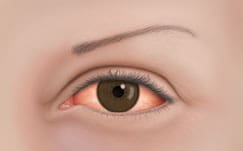What is pink eye?
This is the season for back-in-school kids to spread pink eye.
Call our Maple Grove Eye Doctors (763-416-0622) if you suspect that your child has pink eye. The wait at our office is much shorter than the doctor’s office, and we can bill your medical insurance.
We know eyes. It’s all we do.

Conjunctivitis is the term used to describe swelling (inflammation) of the conjunctiva — the thin, filmy membrane that covers the inside of your eyelids and the white part of your eye (known as the sclera). Often this condition is called “pink eye.”
Signs of pink eye may appear in one or both eyes.
There are 3 types of conjunctivitis:
Bacterial Conjunctivitis is a highly contagious form of pink eye caused by bacterial infections. This type of conjunctivitis usually causes a red eye with a lot of pus.
Viral Conjunctivitis is most common cause of pink eye is the same virus that causes the common cold, and is also very contagious.
Allergic Conjunctivitis is a form of conjunctivitis is caused by the body’s reaction to an allergen or irritant.
It is not contagious.
-
- The most common causes of pink eye (conjunctivitis) are:
• Infections (viral or bacterial);
• Allergies; and
• Irritation from something in the environment.
- The most common causes of pink eye (conjunctivitis) are:
Viral infection is a common cause of conjunctivitis. This same virus that produces red and watery eyes also causes the sore throat and runny nose of the common cold. Symptoms of viral conjunctivitis can last from a few days to two weeks and then will disappear on their own. Discomfort, however, can be minimized with cool compresses applied to the eyes. Antibiotic eyedrops do not cure viral conjunctivitis.
Bacterial infections, such as Staphylococcus or Streptococcus, cause a red eye with a lot of pus. Often the eyelids are glued shut on awakening. Infrequently, bacterial infections will produce little or no discharge except for some mild crusting of the eyelashes in the morning. Antibiotic eyedrops are often prescribed because they speed the eye’s healing and reduce contagion.
Allergic conjunctivitis is not infectious or contagious. It occurs when the body is exposed to something that causes an allergic reaction, such as pollen or other environmental allergen, or pet dander. The primary symptom is itching. Other common symptoms include redness of the conjunctiva, burning, tearing, and puffy eyelids. Occasionally the conjunctiva becomes swollen. Treatment often includes applying cool compresses to the eyes and using anti-allergy eyedrops and artificial tears. Many patients find that drops that have been cooled in the refrigerator are especially comforting. Oral anti-allergy medications do not significantly improve the symptoms of ocular allergies.
Environmental irritants, such as smoke or fumes, may also cau se conjunctivitis. The symptoms are burning and irritation, with no discharge or watery discharge.
How do you get infectious pink eye?
Conjunctivitis, whether bacterial or viral, can be quite contagious. Some of the most common ways to get the contagious form of pink eye include:
- Forgetting to wash your hands often and touching your eyes;
- Reusing tissues and towels when wiping your face and eyes;
- Not cleaning your contact lenses properly and using poorly fitting contact lenses or decorative contacts; or
- Using infected eye makeup.
If you have pink eye, avoid wearing eye makeup and do not share makeup with anyone. Once your infection clears, replace your makeup to avoid possible reinfection. Bacteria can live in makeup and cause pink eye; even worse, it can cause corneal infections, which can be sight-threatening.
Children are usually most susceptible to getting pink eye from bacteria or viruses because they are in close contact with so many others in school or day care centers.

Conjunctivitis is typically a short-lived condition that may require eyedrops. However, if symptoms continue for an extended period of time after treatment, you should have your eyes examined by our optometrist, as these symptoms may indicate a more serious eye problem. Several eye diseases can cause red eye, some of which can lead to blindness unless diagnosed and treated.
Easing Symptoms
To reduce pain and to remove the discharge of bacterial or viral pinkeye, use a cold or warm compress on the eyes. Make sure to use a different washcloth for each eye to prevent spreading any infection. And use clean washcloths each time. Clean the eye from drainage by wiping from the inside to the outside of the eye area.






